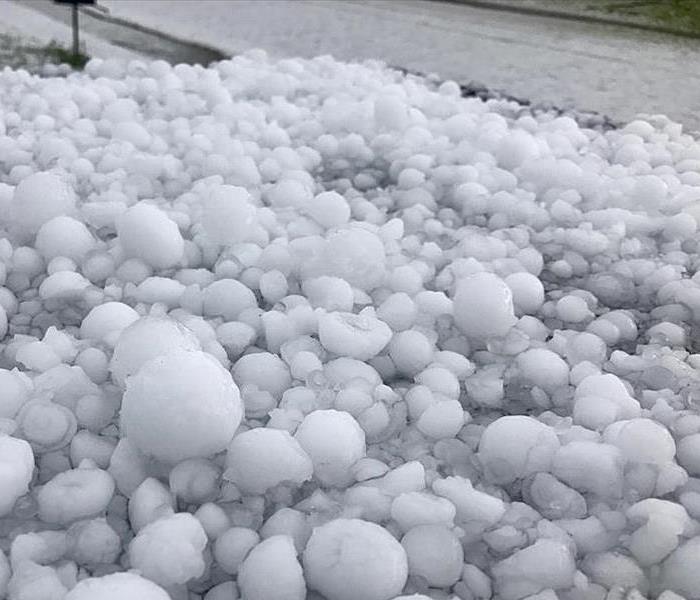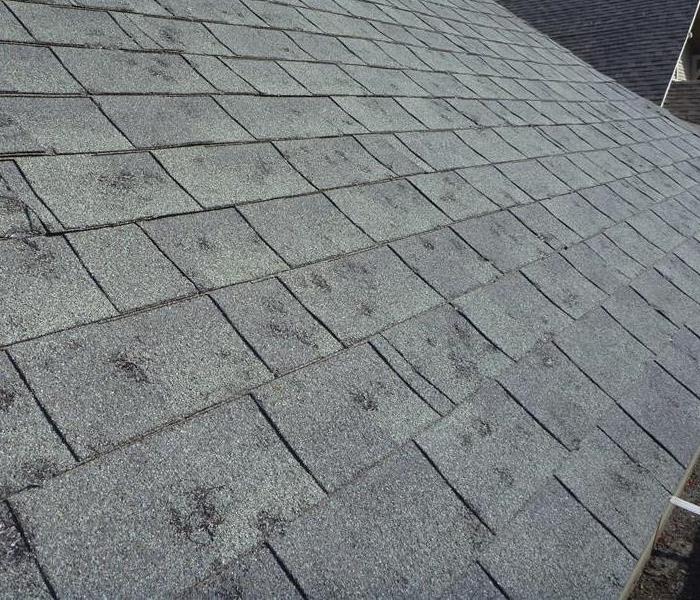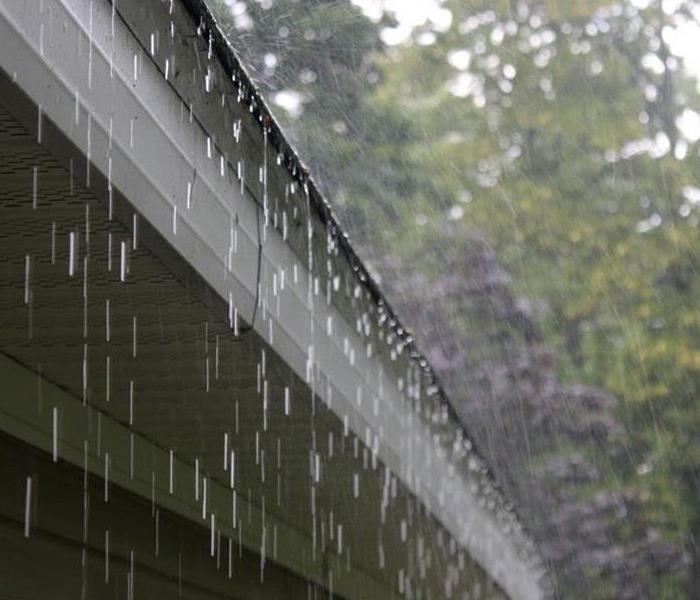Archived Storm Damage Blog Posts
Summer Storms Can Lead to the Need for Water Removal in Omaha
6/6/2023 (Permalink)
Team SERVPRO Arrives Equipped to Handle Your Storm Damage Emergency
The humidity and energy of high temperatures during an Omaha summer can combine to generate storms and local microbursts that can expose your home to significant water intrusion. Extreme weather patterns can dump inches of water on your property in a short period, overwhelming the drainage system on your roof and attached gutters and downspouts.
Severe weather can completely change your daily routine, including forcing you to arrange for water removal inside your Omaha home. Water can flow into your home’s lower levels, requiring professional help from us to protect the integrity of your property’s structure.
Instead of the normally directed flow of water away from your foundation when rainstorms are moderate, torrential rain can force the excess water from your overwhelmed drainage system to seek drier areas immediately as it cascades from the roof. Water is attracted to surfaces and structures that are dry, including the materials making up your basement walls, slab foundation, or crawl space. We are familiar with this process, and our technicians receive training to respond to this phenomenon quickly and reliably.
Calling SERVPRO immediately after the water intrudes allows us to quickly extract standing water out of your home and disperse it away from your foundation. We have generators and our service vehicles have powerful pumps and extractors to evacuate water that is trapped inside your home. We can proceed with water removal even if the storm knocks out power. Our crew lead assesses the scenario and the crew members implement the plan created after the assessment.
Once the standing water is extracted from the lower levels or crawl space, our SERVPRO employees position air movers, and powerful dehumidifiers to remove the moisture that saturated the structural components of the affected area. It is crucial to reduce moisture levels to normal numbers within 48 to 72 hours. More extended periods of elevation can lead to microbial growth and allow porous materials like drywall, paneling, and insulation to deteriorate progressively. Our employees receive training and certification in moisture monitoring during IICRC courses, helping the crew chiefs to determine drying goals that the proper balance of air movement, and reduced humidity can accomplish.
SERVPRO of Omaha Northwest has the team, knowledge, and equipment to remove excess water and residual moisture left by seasonal storms. Contact us as soon as the problem presents. Our phone at (402) 800-2134 is answered 24/7.
Click here for more information on the city of Omaha.
Some of the Worst Flood Damage Remediation Mistakes in Omaha and What They Will Cost You
6/6/2023 (Permalink)
Flood Damage Concerns During Winter Storms In Omaha
Any given winter storm coming to the Omaha area can bring with it a variety of types of precipitation. Although snow is generally expected, sleet, and flooding rain are also common as storm fronts roll through. Regardless of the season, homeowners enduring the devastation of flooding need a remediation company with the trained technicians and up to date equipment capable of removing the water and thoroughly drying the structure to mitigate damage. We are up to the challenge.
The colder temperatures in the winter months make rapid mitigation of flood damage in Omaha essential. Because heating systems often have their base unit in the basement or lower level of a home, excess water can interfere with the climate control in your home. With freezing temperatures looming, a potential failure of your heating system exposes your home to even greater risk. Pipes can freeze, sending even more water into the house. Drying usually takes longer, and your family might need to relocate while the issue is resolved.
When SERVPRO arrives on the scene our experienced crew lead will plot out a course of action. The crew members work immediately, following the crew leader's plan. No delay is necessary because our service vehicles are fully stocked with our tools of the remediation trade -- pumps, extractors, air movers, heaters, and dehumidifiers as well as cleaning and sanitizing equipment and products.
Our goal is to remove the standing water, including any water that migrated into cavities between walls or other hidden spaces. SERVPRO crew members are trained to IICRC Standards, including the use of moisture detection equipment that assists us in finding even hidden flood waters. Once our pumps and extractors remove the water, we set up a drying perimeter. Achieving the proper balance of air movement, temperature, and relative humidity pulls water out of the structural components. The resulting water vapor is condensed and absorbed by our dehumidifiers, and for disposal.
The final steps SERVPRO completes include disinfection with EPA registered antimicrobials. We work quickly to remove and dry out the water to prevent mold from gaining a foothold, but the sanitizing steps help inhibit the risk. After our work crew wraps up the project your home is ready for any restoration needed by your chosen contractor.
SERVPRO of Omaha Northwest is ready to respond to flooding disasters 12 months out of the year. Contact us at (402) 800-2134 to schedule an assessment if you struggle with winter flood damage.
Click here for more about Omaha.
Prevent Basement Flooding from Snowmelt
6/6/2023 (Permalink)
Extreme Temperatures
Eastern Nebraska is known for extreme weather changes. Temperatures can vary 100 degrees between the summer and winter seasons. Even in the winter months, the climate can rapidly change. It is not uncommon to have a 60-degree day immediately following a heavy winter storm.
These extreme temperature changes make flooding a potential hazard in the Omaha and surrounding areas. The sudden melting of packed ice and snow can cause rapid runoff. If the ground is still frozen, snowmelt has no place to go and can find its way through the foundation of your structure. Homes and businesses located near creeks and rivers are at higher risk for flooding.
Some tips to prevent a flooded basement include installing a sump pump and making sure downspouts drain 20-30 feet away from your home or business. Hiring a company to professionally waterproof the basement is another option. Using a snow-blower around your home’s foundation and removing snow from the roof when safe are additional ways to limit water intrusion from snowmelt.
Call Us Today for Your Winter Weather-Related Needs
Even when preventative measures are taken, your Nebraska business or home may experience leaks and flooding. The team at SERVPRO of Omaha Northwest is trained in water extraction and structural drying. Our employees are IICRC certified and use the most up-to-date water mitigation practices. Rest assured, the team at SERVPRO of Omaha Northwest will help make any water damage “Like it never even happened.”
402-800-2134
Summer Storms Contribute To Water Damage In Fremont
2/1/2023 (Permalink)
High winds and heavy rains may be a common challenge in Fremont during summer. Usually, your home will be up to the challenge, shedding the water and maintaining its integrity against the power of the gales. If the force of a storm pulls up a portion of the roof or brings a tree crashing down, taking out part of a wall or some windows, a massive quantity of water can enter your house. We have every resource to remove the water and dry the structure in preparation for further repair and restoration.
Sudden and severe water damage to your Fremont dwelling can happen in an instant when a summer storm bears down. You as the homeowner must seek an immediate solution. Our crew will assess the water damage and develop a plan to remove standing water and dry the structure in anticipation of your contractor's rehab and restoration.
SERVPRO focuses first on fast and thorough water removal. Our technicians master IICRC courses in Water Damage Restoration and Applied Structural Drying to ensure we complete our water damage mitigation to the highest disaster recovery industry standards. We utilize submersible pumps and commercial grade extractors to extract the water swiftly. As the storm borne water flowed from upper levels to lower in your home, saturating recesses along the way, we must be sure that we find and remove all traces.
Our crews use moisture meters and scanning devices to determine the extent of water migration and set appropriate drying goals for each area of the house. Our SERVPRO Green trucks have a full complement of air movers, heaters, and dehumidifiers onboard, enabling us to move directly from extraction to drying. We position the drying equipment according to our training and experience for the fastest and most efficient results and continuously monitor the decrease in moisture levels so we can return your property to you when it is ready.
Turn to SERVPRO of Omaha Northwest when storm damage leads to standing water and saturated structural components. Call us at (402) 800-2134 for a response day or night, 365 days a year.
Click here for more about Fremont.
Arrange for Fast and Reliable Storm-Based Water Removal in Omaha
8/9/2022 (Permalink)
SERVPRO Can Provide Water Extraction and Drying Services after Storms
Omaha frequently is in the path of severe storms. Heavy rains exacerbated by wind and tree damage that can expose a home to vast quantities of water that can collect in lower levels and recesses. Attempting to manage water removal on your own is inefficient and usually incomplete. Our technicians have both the experience and equipment to help finish the job professionally.
Water from storm damage that remains in your Omaha home for an extended period of time can continue to migrate further into your home and deeper into the materials. The longer it is present, the more damage it can do. Excess moisture can cause mold to begin to grow, causing further damage and presenting potential health effects. That is why it is important to call us immediately after a storm damages your home.
Our SERVPRO crew can arrive at your home with the equipment needed to begin the remediation onboard our trucks. An experienced Production Manager can assess the scenario quickly, meaning there will be no delay in our response. The longer water remains pooled inside your structure, the more likely permanent damage can compromise your home’s building materials and contents. Responding fast also reduces the chance for microbial and chemical contamination of any standing water, which reduces both the potential health hazards and the cost of the cleanup.
The SERVPRO crew can extract any standing water, employing several different devices and techniques. Groundwater flooding that enters your home from outside can generally be pumped directly back outside. Interior flooding from other sources must usually be captured. Our employees can measure moisture levels in the ambient air inside your home, in the building's structural components and finish materials, as well as the contents of your home. There are different types of diagnostic equipment and sophisticated scanning devices to locate water that may have migrated into hidden recesses. We may need to remove sections of drywall, drill holes in brickwork, and find other innovative ways to get at and remove trapped moisture.
Once the water is invisible to the naked eye, we calculate drying goals based on the moisture meter readings. SERVPRO employees place air movers, heaters, and dehumidifiers in the most optimum pattern to achieve the drying goals. When moisture levels return to normal, you and your contractor are ready to take additional steps to repair the now-dried areas.
SERVPRO of Omaha Northwest wholly and swiftly remediates water losses to your home and outbuildings. Call us at (402) 800-2134 to schedule an assessment and planning session so we can help remove the weather-related water standing in any spaces within your house.
More city info by clicking
Storms Brew Up The Need For Water Removal In Omaha
6/17/2022 (Permalink)
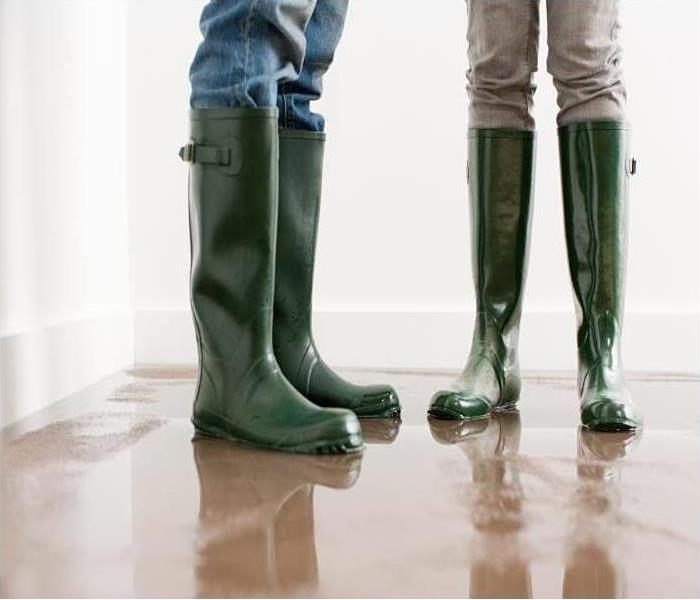 After a storm ravages Omaha, some homeowners discover they have a pressing need for water removal services.
After a storm ravages Omaha, some homeowners discover they have a pressing need for water removal services.
Storms Brew Up The Need For Water Removal
Heavy rains, wind, hail, and the potential for tornadic activity is a typical weather forecast in Omaha during the spring and early summer. If your home is in the path of this kind of severe precipitation mix, prepare for the possibility that water incursion can place your home at risk of significant and continuing damage. Professional equipment and technicians can reduce the threat quickly.
After a storm ravages Omaha, some homeowners discover they have a pressing need for water removal services. When several inches of rainfall in a short period, water can find its way to invade the lower levels of your residence. The saturated soil around your foundation can force water up through gaps and cracks, and if wind or hail damages siding, windows, or roofs more rain can pour inside. This scenario is the definition of an emergency; the kind we are continually ready to resolve.
Once you have stopped the intrusion of additional moisture, removal of the water already saturating the interior is first on our agenda. Standing water must be removed fast, and it can hide in many spaces in your basement, foundation, or crawl space. SERVPRO crews are experts in pumping and extracting the water you see, and detectives when it comes to locating the water that collects in difficult to reach spaces. We use moisture meters and infrared scanners to pinpoint where caches of water can linger. Our training prepares us with strategies to remove all traces, including drilling holes in mortar joints or removing selected areas of paneling or drywall.
Insistence upon speedy removal on both your part and ours helps reduce the likelihood of microbial growth. Quick removal and drying will also help to reduce the ongoing creep and saturation that happen when standing water is allowed to remain for an extended period.
SERVPRO of Omaha Northwest prides itself on a fast response to your water disaster. Call (402) 800-2134 immediately to ensure our crews are on site as soon as possible, removing the water before permanent damage can happen.
What to Do When a Storm Floods Your Omaha Home
6/10/2022 (Permalink)
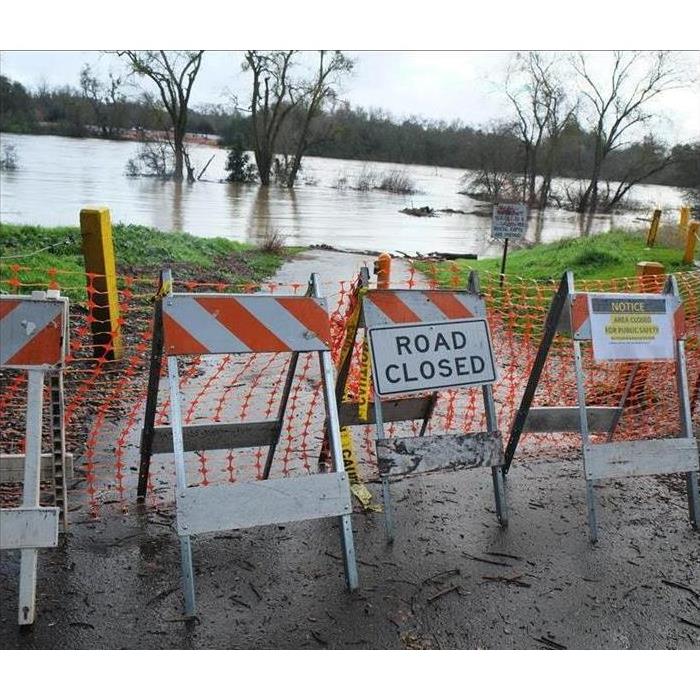 After Flooding in Omaha, Calling SERVPRO is the Right Road to Water Removal and Restoration
After Flooding in Omaha, Calling SERVPRO is the Right Road to Water Removal and Restoration
Flooded Omaha Properties Rely on SERVPRO for Water Extraction and Cleanup
The potential of your home to sustain flood damage increases when the city that you live in is adjacent to a river. In the case of Omaha, seasonal storms and the spring thaw can bring flooding from the Missouri River. The flood can carry debris that adds to its destructive force, breaking down doors and windows allowing the water, mud, and debris to enter your home. Once inside, it can soak into the structure of your house and leave you with a significant problem. Fortunately, qualified and professional help is not far away.
Our IICRC-certified technicians are trained to handle the damage from the flood waters in your Omaha residence. After receiving your call, we can send our technicians to your home as soon as possible to inspect the damage. Unfortunately, flood water can contain pesticides, toxins, and sewage, and the area must be treated as biohazardous. The unclean water can damage your belongings and make porous materials such as carpet unsalvageable.
While the final decision on what to keep and what to discard rests with you, SERVPRO can help you sort through what is safe to keep and recommend what to throw away. We even provide a CCIS; a claims form for cataloging. Afterward, we can assist you with the process of filing a claim with your insurance company to make the entire situation more comfortable and less confusing. After completing the cleanup, our technicians can start the drying process.
Here at SERVPRO, we use a variety of advanced technologies to dry out your home. Using a combination of air movement, low grain refrigerant dehumidifiers, and desiccant dehumidifiers, we can ensure the ideal environment for evaporation. Creating the proper conditions in the affected areas is crucial to the drying process, as your property cannot be rid of the moisture without assistance.
When your home sustains flooding damage from a storm, do not hesitate. Call SERVPRO of Omaha Northwest at (402) 800-2134. As soon as possible, we can send our technicians to your home to help make you feel "Like it never even happened."
Prepare Your Elkhorn Home Against Flood Damage
6/6/2022 (Permalink)
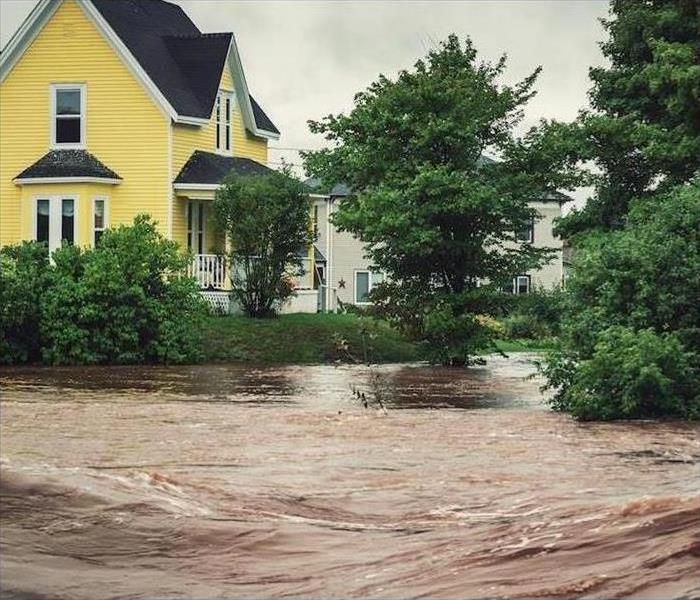 Dealing with flooding can be overwhelming. For cleanup services and prevention tips, contact SERVPRO right away after an event.
Dealing with flooding can be overwhelming. For cleanup services and prevention tips, contact SERVPRO right away after an event.
SERVPRO Offers the ERP Program to Help Prevent and Mitigate Damage Caused by Flooding to Your Elkhorn Property
Flooding is a common disaster that leads to millions of dollars worth of damage for homeowners every year. Although it is nearly impossible to protect your Elkhorn home altogether, there are many ways for expertly trained flood damage restoration specialists to help you avoid or reduce damages a flood may cause.
Working with an expertly trained local professional can drastically increase your home's chances of surviving flood damage in Elkhorn. Having a pre-existing relationship provides you with access to IICRC certified technicians who know your property and have the personnel, equipment, and resources available to help during an emergency.
Your SERVPRO team can help mitigate flood and water damage. We offer a mobile app for both residential and commercial customers. Ask us for a free consultation regarding the ERP, Emergency Ready Profile Plan for your property. Many valuable tips, contact information, and chain of command for decision-making are a few factors that arm you against the unexpected. Our goal is to prevent on-going damage as we extract the flood waters and any accompanying debris.
Negative grading often affects the flow of rainwater, which can gather along your foundation, rather than moving away as intended. Taking the opportunity to slope the ground away from the structure, making adjustments to existing landscaping, installing interior and exterior backflow prevention valves, sump pumps, and other drainage measures can help prevent flooding or sewage backups.
SERVPRO strongly advises implementing these suggestions as part of the ERP Program. We strive to provide excellent restoration services and help you limit the many ways water has to enter the home, protecting your home, contents, and personal belongings from flood damage whenever possible.
Remember, flooding can occur any time of year. However, storms are more common during Springtime and often lead to flooding in your home. We can help you extract unwanted flood water from your property, clean-up and restore salvageable items while drying, disinfecting, and deodorizing to complete our flood damage restoration service. Rebuilding or reconstruction of flood-damaged structures by a licensed contractor can then begin.
Contact SERVPRO of Omaha Northwest for full details regarding cleanup and restoration services available to homeowners throughout Omaha and Bennington as well. We are proud to serve every member of our local community and strive to provide you with detail-oriented, trustworthy restoration services you can count on, call today. (402) 800-2134
Remediation of Contaminants Complicating Flood Damage
2/9/2022 (Permalink)
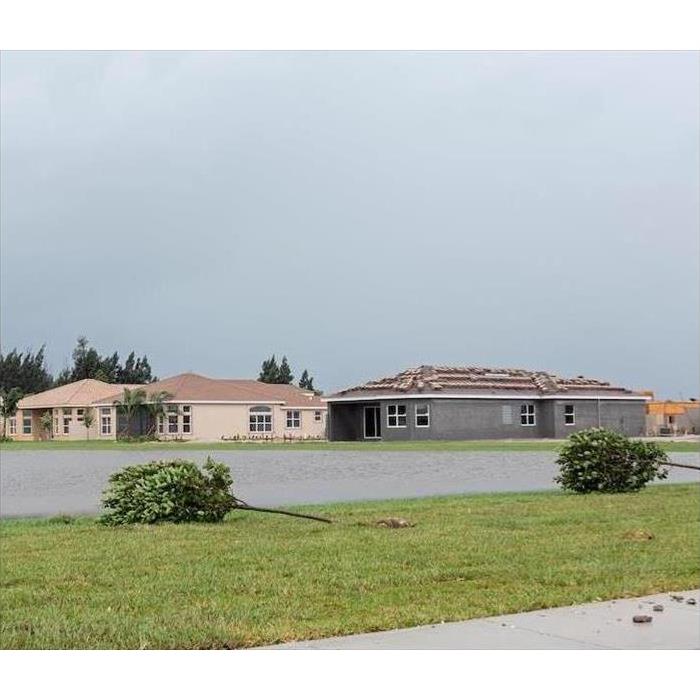 Contact the specialists at SERVPRO after flooding in your home. One call starts the process from an assessment to restoration.
Contact the specialists at SERVPRO after flooding in your home. One call starts the process from an assessment to restoration.
SERVPRO Technicians Assess the Type of Water that Has Flooded Your Property Before Beginning the Drying Out Process.
Heavy rains can cause concentrations of flood waters in the Omaha area. Proper handling of flood water that may contain hazardous materials and sewage can be a complicated problem. Simple removal of the water is not always adequate, requiring instead containment and disposal of potentially contaminated mixtures of rain runoff, infectious waste, and chemicals. Professional water removal and damage remediation is a must under these circumstances.
Homes in the path of flood damage in Omaha need intensive efforts to minimize the dangers posed by potentially contaminated water. If the water invading residences are not handled properly, your family risks illness, chemical hazards, and injuries. The structure and contents of your home can also suffer a range of catastrophic consequences as flood waters flow through and collect in living spaces. Our technicians master techniques to help safeguard your personal health and building integrity even after a significant flooding event.
Local codes require gray and black water that has been extracted and contained to be disposed of using methods to protect individuals and the greater community. Pumping and extraction equipment must have the power and capacity to clear enormous quantities of fouled and potentially hazardous water quickly. SERVPRO service vehicles carry submersible pumps, industrial strength extractors, and emergency power generation equipment to operate under storm conditions.
The flood remediation team takes baseline moisture readings for structures and interior air as the majority of standing water exits via pumping and suctioning technology.
Advanced scanning technology can identify pockets of moisture in wall cavities, under flooring, within foundation structures, and in other recesses. SERVPRO workers use their training and experience to remove this trapped moisture, opening up sections of drywall or paneling and drilling holes in cinder block, concrete, or mortar joints to expose and release flood water. Periodic moisture level re-measurements reveal if drying techniques utilizing air movers and dehumidifiers are succeeding on achieving industry drying target standards.
Drying wet materials and applying professional antimicrobial treatments helps to inhibit the growth or spread of potentially harmful microbes such as mold, bacteria, and viruses. SERVPRO presents your cleaned, dried, and sanitized home after our crews complete flood damage remediation.
Transforming your home from contaminated, watery chaos to a dry, clean, and infectious waste-free space is the mission of flood damage specialists at SERVPRO of Omaha Northwest. Call (402)800-2134 day or night for an assessment and project plan.
For more information about the City of Omaha, Nebraska visit: https://www.visitomaha.com/
Protect Your Home from Winter Weather
12/19/2021 (Permalink)
With the temperatures dropping and snow falling make the right decisions on keeping your home safe from fire and water damage this winter. If you live in an area with harsh winters consider the following:
-Make sure to clean your gutters every spring and fall. If your gutters aren't clean snow melting off your roof will back up in your clogged gutters and potentially cause water to back up under your roofline. The snow melting on your roof occurs when either the heat from the sun or heat from your house escapes and the attic warms the roof. Snow then melts off the roof and refreezes making an ice ridge that traps water on your roof. That water stuck in those ice ridges can leak into your home and can cause some serious damage. To prevent heat from continuously ventilate the attic air.
-Plumbing...the dreaded frozen pipes! Plumbing located on exterior walls or unheated crawl spaces is most likely to be your culprit for a bursting frozen pipe. All interior pipes should be insulated and exterior pipes should have weather resistant insulation for protection. Don't forget to disconnect hoses from your outside water faucets. If you believe there is a frozen pipe somewhere in your home, shut off the water main and call a plumber to resolve the problem before more damage occurs.
-Fireplaces and other indoor heating systems with poor maintenance can cause fire, puff-backs and smoke damage. A fireplace is beautiful and keeps your home warm with low electricity bills but without proper care it can cause a house fire. Clean chimneys and flutes on your fireplaces annually. Get your furnaces checked once a year and keep space heaters 3 feet or the recommended length away from any flammable objects. This includes window blinds/curtains, furniture, bedding, and decorative rugs.
-Take further precautions by changing your smoke alarms batteries every 6 months and don't forget to replace your smoke alarms after 10 years.
Not everything can be prevented but take the steps to prevent as much of the damage as possible. Have a safe winter season.
Cleaning Up Flood Damage after Storms Hit Omaha
8/13/2021 (Permalink)
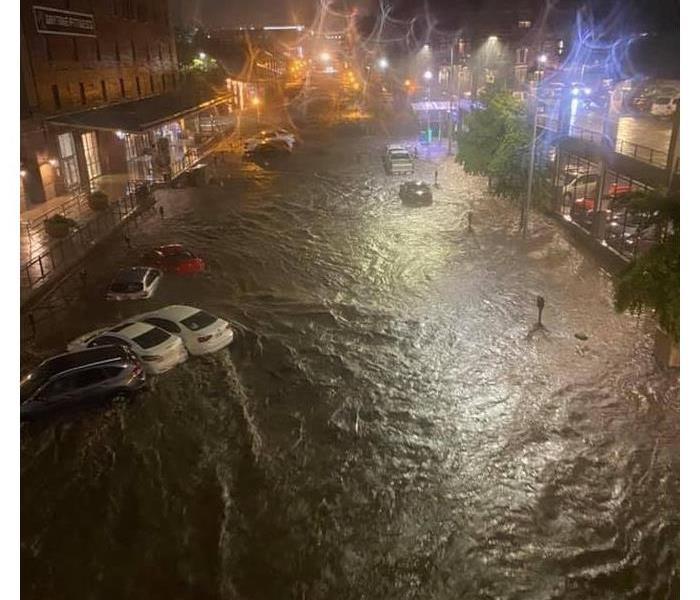 Recent flash flood in Downtown Omaha
Recent flash flood in Downtown Omaha
SERVPRO Mitigates Omaha Area Storm Damages with a Fast Response
There are many reasons why a storm can create localized flooding in Omaha. As the open land areas around your neighborhood are developed more and more into homes, offices and retail, the soil beneath them that once absorbed rainfall is now covered with roadways and buildings that shed rain run-off. During storms local drainage systems, creeks and rivers can be overwhelmed by the rapid run-off and begin to overflow. Recent construction can change the way rainwater flows, affecting areas that have never experienced flooding problems in the past, and torrential downpours can simply douse an area too quickly for the rain to disperse harmlessly. A "wet microburst" is a small storm event, usually no larger than a few square miles, that can bring both high winds, torrential rainfall and hail in a very short time which can quickly overwhelm local flood control systems.
Homes in or near Omaha can suffer flood damage and other harmful effects from microbial and chemical contamination during severe storms. Between the state of flooding and any resulting reconstruction work that must be done, a flooded home needs mitigation to reduce potential water damage and restore building materials that can be saved. Rapid water extraction can significantly reduce reconstruction costs. Our SERVPRO technicians are trained, certified and experienced in flood damage mitigation. We start by using both truck mounted and portable pumps to remove the standing water on non-porous surfaces and extract it from carpeted floors. We then employ drying equipment for rapid drying to reduce the amount of water damage the materials inside your home can suffer.
Since flooding brings in more than water, we also thoroughly clean and sanitize each home during the remediation process. As rainwater travels away from where it fell onto the ground, the run-off picks up pollutants such as automotive fluids, fertilizers, pesticides, and even raw sewage. Groundwater flooding that enters your home can bring pollutants from these and other sources that can seep into porous materials such as carpet and padding, drywall, insulation in exterior walls, upholstered furniture, and anything else that flood water saturates. Homes can also have substantial amounts of washed-in debris such as garbage, tree branches, leaves, silt, and other objects that require fast and complete removal.
SERVPRO of Omaha Northwest has the tools, skills, and IICRC certificates to prepare your flood damaged home for reconstruction, saving you time, money, and aggravation. No matter the time or day of the week, you can contact us by calling (402) 800-2134.
Restoring Flood Damaged Flooring In Omaha
6/30/2021 (Permalink)
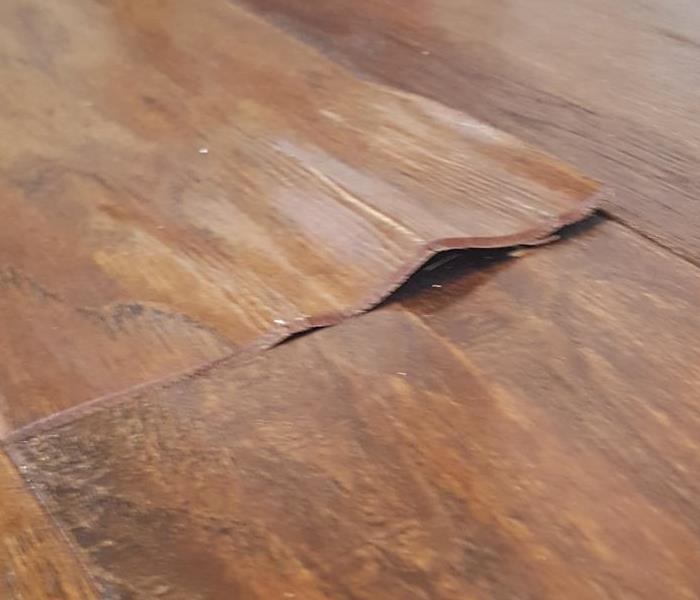 This picture shows what water can do to hardwood floors
This picture shows what water can do to hardwood floors
Flooding costs Nebraska homeowners millions of dollars every year. It can often be a seemingly small incident, such as a malfunctioning dishwasher or a leaky pipe under the kitchen sink that surprises residents with how much damage can occur over time.
Mitigating flood damage in an Omaha home means inspecting and remediation. When water goes unnoticed or ignored for an extended period, floors can buckle, carpets rot, and even worse can happen. With our floor mat drying system, we find we can restore most wood floors, but if it has remained saturated with moisture for too long, it may have to be replaced.
If water has penetrated the sub-floor and the structural materials are also saturated, we can usually dry the floor cavity with a cavity drying system or heated drying system that forces warm, very dry air below the subfloor. The subfloor materials can also be accessed from the crawlspace, or from a lower floor by removing the drywall from the ceiling beneath. These types of drying jobs usually take longer to dry - from 4 to 7 days. In rare cases, it may be necessary to remove the subfloor, such as when mold has damaged the subfloor or structural materials beyond remediation.
Although we want to get residents back in their homes quickly, we also want to restore it properly the first time. Our technicians and work crews check and recheck each area to ensure all the water damage has been restored and the humidity is within a safe range.
Returning your home to its pre-flood condition takes a lot of time and effort, but it is necessary to prevent further damage or potential health hazards. A professional remediation service will not only restore all of the water damage but make sure you understand each action and why we do it. If you need our services, call SERVPRO of Omaha Northwest at (402) 800-2134 today. We are here for you.
Call SERVPRO for Assistance After A Flood In Omaha Flood Damage
6/29/2021 (Permalink)
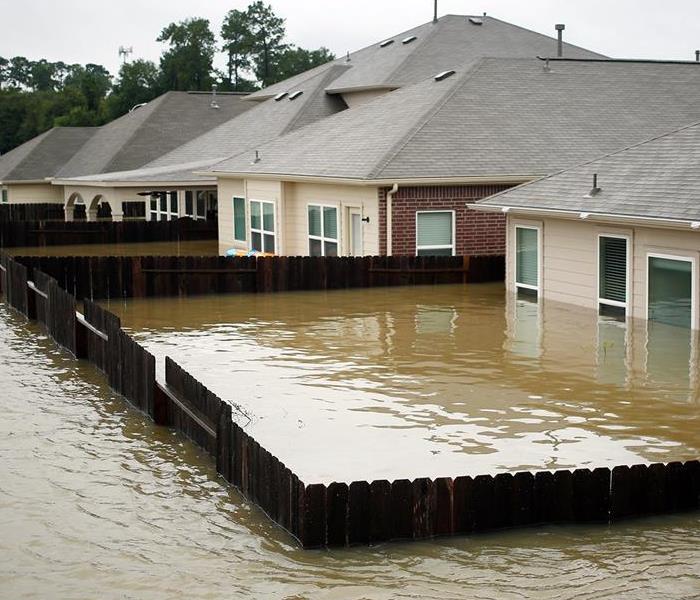 Flooding can cause significant damage to your property.
Flooding can cause significant damage to your property.
We help homeowners deal with flood damage or other water damage events on their property nearly every day. In fact, flooding in home and businesses happens frequently enough that an entire industry has grown to help people recover from it.
Omaha area residents can benefit from flood damage information provided by a local mitigation company, giving them their best shot at repairing their home should an incident occur. When flooding takes place in your home or business, SERVPRO of Omaha Northwest can provide valuable information that can make the difference between a fast recovery and a long, tedious project that never seems to end.
The question that everyone has in mind when their home or business floods is whether their insurance coverage will be sufficient to repair the damage to their home or office and personal items. While flood insurance is usually a separate policy from your standard home or business insurance, only your insurance provider can answer that inquiry for certain. Contact your insurance agent BEFORE a flood occurs to ensure you have the proper coverage, especially if you live in a flood-prone area.
If a flooding event occurs on your property, of course, your first move should be to make sure that your family is safe. You can notify your insurance company after everyone reaches safety. Then call SERVPRO of Omaha Northwest as soon as you can gain access to your property, and the flooding has subsided. Remember that the sooner the mitigation process can begin, the less damage will be incurred by your home or office and your belongings.
Homeowners also like to know how much our services cost, or if they might experience any costs themselves. For most situations, your insurance company covers most, if not all of the expenses associated with your restoration process. SERVPRO understands how important your home is; we take working with you and your insurance company seriously, providing you with the results you deserve while keeping costs as low as possible.
Start things off on the right foot: contact SERVPRO of Omaha Northwest for preparation information such as an Emergency Response Plan (ERP), an initial inspection, or to begin your home's mitigation process today. We are available 24-hours a day, every day of the week prepared to put qualified technicians to work for you (402) 800-2134.
Need Professional Flood Restoration Services? SERVPRO Can Assist
6/25/2021 (Permalink)
 SERVPRO of Omaha Northwest has the experience and expertise to restore your home from flood damage!
SERVPRO of Omaha Northwest has the experience and expertise to restore your home from flood damage!
Many modern conveniences inadvertently become liabilities when they break or fail to shut down or cycle off. Often these systems involve water -- water heaters, washing machines, ice makers, dishwashers, tubs, pools, and much more. The overflow of water can flood your home, requiring a call to a highly rated restoration company for mitigation and restoration.
Flood damage to your Omaha kitchen can happen when indoor ice and water servers malfunction in your refrigerator. Gallons of water can spread over your floor, under other appliances, and into additional rooms. You need a speedy, professional response to such a disaster, including well-trained technicians to make educated decisions and use the proper equipment to set your home back to preloss condition.
Water pulsing out of the ice maker on your refrigerator door will be clean initially, but the widening pool can pick up the dirt, grease, and hidden food particles caught beneath and between the stove, dishwasher, cabinets and refrigerator. Experienced flood and water damage responders such as SERVPRO know that water can swiftly turn from clean to tainted the longer it stands without removal. Any organic material that was affected and remains wet gives microbial growth a boost once the water activates the growing process. A team that extracts the standing water fast is vital to limiting potential health hazards and damage to the structure and contents of your home. Ensuring that moisture dries out before mold gets a toehold is one of the core missions of a high-quality water damage restoration company.
High-efficiency water extraction equipment and trained technicians pull the standing water out. Drying goals determined by the same skilled staff achieve completion through the addition of air movement and dehumidification. Throughout the process the restoration company’s staff evaluates the progress, checking for leaks to other levels of your home and the condition of porous materials such as drywall, carpeting, and cabinetry. This evaluation involves a complex series of steps, informing the water restoration technician's decisions on what to clean, dry, and restore, versus what items and structures require removal and replacement for health and safety reasons.
Selecting the correct alternative demands familiarity with the water damage restoration industry. Trying to manage without professional help risks secondary damage to your house and possible health hazards to your family where potentially infectious microbial growth remains unabated. Acquaint yourself with a top-notch flood damage restoration company to move past this disaster.
How to Prepare for the Possibility of Flooding
2/10/2021 (Permalink)
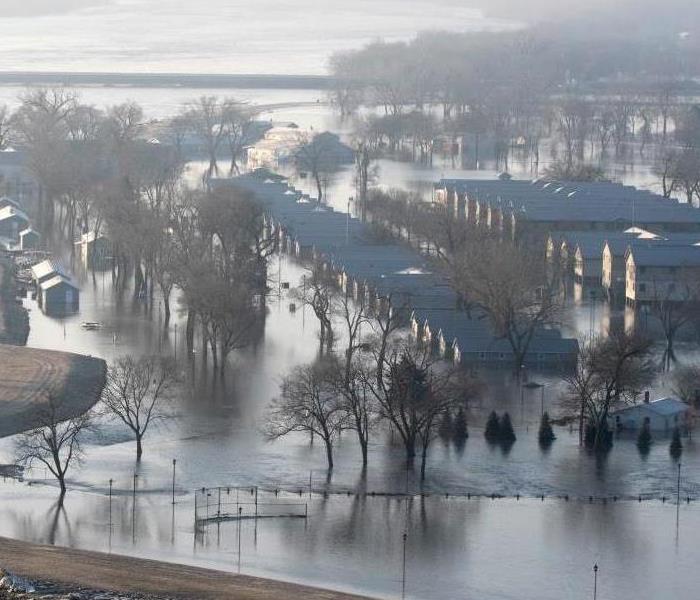 Nebraska floods from March of 2019
Nebraska floods from March of 2019
Storm season can certainly keep you on your toes. When you have a business the Omaha area it’s good to know how to prepare for the possibility of flooding. Here are five tips to help you be well prepared for anything a storm may send your way.
Have an Emergency Plan
A big part of preparing for flood damage is simply having a plan of action in place. Evacuation paths should be mapped, and those maps should be posted on every level of your building so that people know where to go in an emergency. Designate emergency responsibilities before the disaster occurs so that people know what is expected of them.
Waterproof Your Building
Make sure you have good drainage for your building. It is also good to have your building inspected regularly to find cracks or spots that are worn so that you can get the necessary repairs.
Elevate Equipment and Furniture
Electrical equipment and furniture can both be damaged beyond repair during flooding. Elevate furniture, sockets, electrical panels, appliances and all wiring where floodwaters can’t get to them.
Have Sandbags Ready
A good way to stave off excess water is to put up barriers. Set sandbags near doors, windows and other vulnerable entry points to your building. Barriers may delay the flow of water enough that you can avoid storm damage altogether.
Update Your Insurance Coverage
It’s a smart idea to check your insurance policies periodically to make sure that all potential problems are covered. If you don’t have a policy that pays for services from storm cleanup experts, you may have to pay for a lot of damage out of pocket the next time a storm heads your way.
Flooding is a common occurrence when there is a storm in your area. By making sure your employees, your building and your insurance is adequately prepared, you can prevent a lot of damage and handle the problems that do occur with relative ease.
Driving in Winter Conditions
12/24/2020 (Permalink)
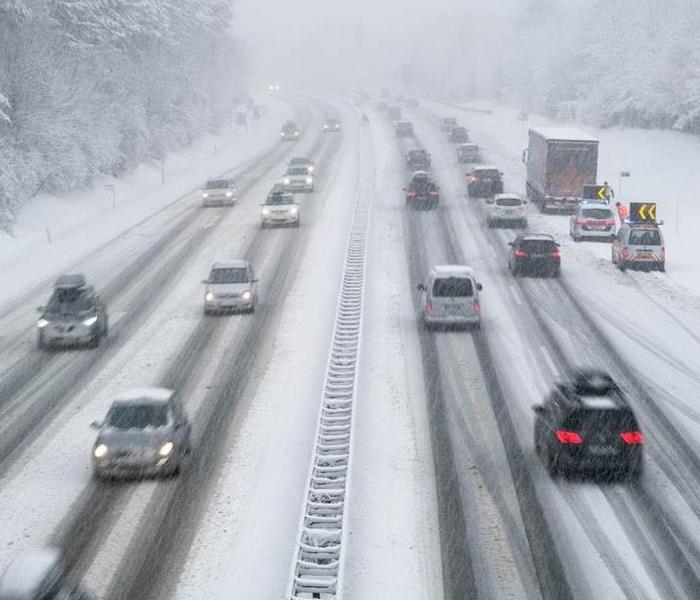 17% of all vehicle crashes happen in winter conditions.
17% of all vehicle crashes happen in winter conditions.
If you get caught in the cold during the winter the consequences are serious, you are vulnerable to things like frostbite, hypothermia, and even heart problems. With cold weather right around the corner it is best to be prepared for winter storms and the things that come with it. Make sure to monitor road conditions before you get in your car to make sure the roads are ok to drive on. Listed below are some tips that can help you be prepared for driving this winter.
Make Preparations
It is always important to prepare before you travel, some things you can do to make sure you arrive safe include
- Check/ Replace windshield wipers
- Check/ replace tire (winter tires may be necessary)
- Pack an emergency kit
- Make sure you always have enough gas
Before leaving you house:
- Clean off the snow on your car. Having snow on your car while you’re driving is putting yourself and other drivers at risk
- Let someone know when you’re heading out
- Check the weather forecast/ road conditions before heading out
How to drive during snowy conditions
Snowy conditions bring low visibility and with winds it can be even worse. When you are driving be sure to keep your distance between you and other vehicles, this will allow some stopping distance in case the roads are slick. Some other things to watch out for include black ice, reckless drivers, and isolated ice patches.
Ways to Prepare for Storm Season
8/12/2020 (Permalink)
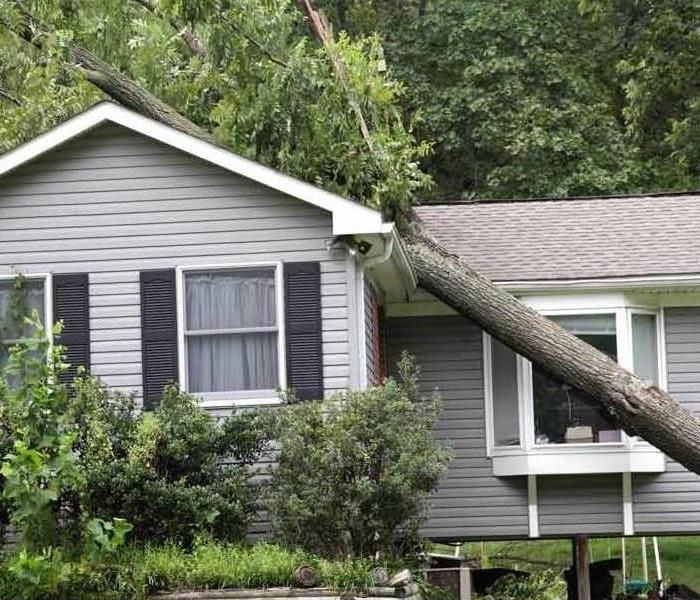 Aftermath of a storm that caused a tree to fall on this house
Aftermath of a storm that caused a tree to fall on this house
Preparing for storm season can easily get overlooked, but you can never be too cautious when it comes to protecting yourself and your home. Summer storms can happen in a moment’s notice and if you haven’t prepared you could have a tree falling on your house due to high winds or could even end up with water in your home due to poor drainage. Below I am going to talk about some of the things you can do to help prepare for things that could happen.
Have a generator ready- Having a generator ready to go when you power goes out is essential. If a big storm happens to come through your town the power could be out for days. Leaving you without air conditioning, powered appliances, or electronics.
Prepare an emergency disaster kit- If possible, prepare an emergency disaster kit. This should include a battery-operated radio, flashlights and a cell phone with a portable charger or other source. It is also smart to keep at least 3-5 days of food supplies if you get stranded, it’s possible things could be shut down based on the severity of the storm.
Trim trees- Trim your trees around your house before storm season, otherwise it could be a costly mistake. Flying branches and falling trees are some of the most common causes of damage during this season.
Clean gutters- Before the season remove leaves and other debris from your gutters. This will help properly drain all of the water and prevent your house from getting water damage.
Waterproof your house- This step refers to checking for holes and leaks in your home. Check your roof and other small holes that could cause problems during a major storm.
What To Do Before and After a Flood
7/1/2020 (Permalink)
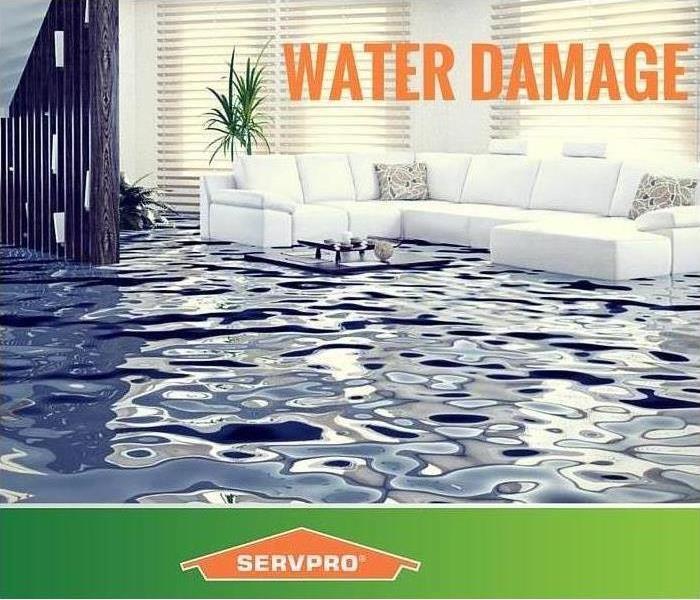 This picture is showing what a house looks like after a flood or water loss
This picture is showing what a house looks like after a flood or water loss
During a flood making sure you and your family are safe should be your number one priority. While your home and property remain as one of your top concerns it is easy to lose sight that safety is more important. In today’s blog, we are going to talk about things you can be doing to prepare, as well as what you should be doing before, during, and after.
Before
To prepare for a flood that is a potential threat you should:
- Build an emergency kit and communications plan
- Avoid building in a flood zone
- Elevate things like the furnace, water heater, and electric panel
- If possible, construct barriers to stop floodwaters from reaching your home
During
- Listen to news sources to stay updated with what is going on
- Be aware that flash flooding can occur in a moment’s notice if it happens to move to higher ground
- If you have to leave, secure your home
- Bring in outside items that could be damage
- Turn off utilities
- Move important items to a higher level
After
- Call Your Insurance Company
- Take pictures of the damage
- If serious damage a restoration company is recommended
- Remove Water
What To Do If Your Basement Floods
7/1/2020 (Permalink)
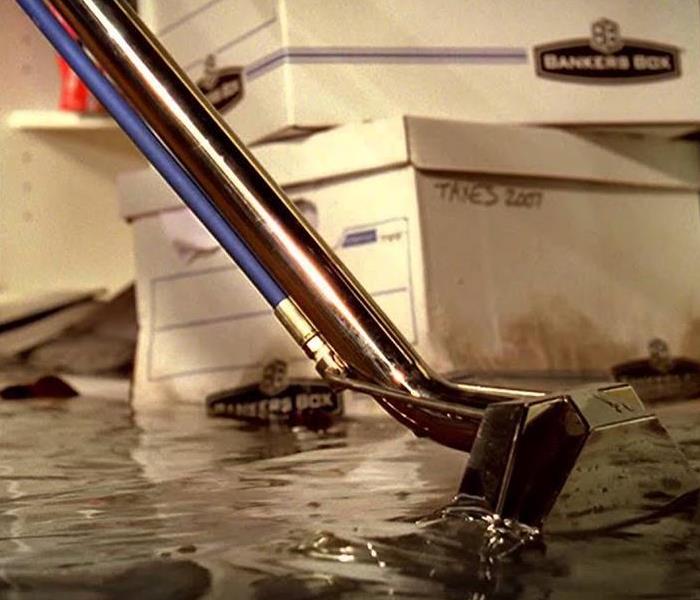 Aftermath of a flooded basement
Aftermath of a flooded basement
Have you ever had your basement flood or have some water get inside after a storm? Some basements are more common to flood and it can be a very overwhelming experience. If your basement is flooding all of the time, then there could be serval issues causing that to happen. In this storm blog, we are going to talk about the things you can do once your basement is flooded. Being prepared and having a plan can help prevent a lot of damage to your home as well as your things.
Below Listed are a few things to do before help arrives, if the basement is finished you may not be able to complete some of these steps because a lot more material will be affected.
- Shut off any power or gas around the area. Never enter an area that is flooded while the power is on.
- Take action after the storm has passed
- Wear protective gear
- Make sure all floor drains are not covered, this will help drain the water
- Start to remove the water from the basement; If there is a lot of water use a sump pump or a pool pump. Once that is complete use a wet/dry vacuum and mop and bucket to clean up what you can.
- Next move on to your items that are affected by the water damage. Move your items that have water damage to a place where they can dry out, otherwise, bacteria will grow like mold and mildew.
- Pull up carpets and dry/ toss
- Give basements several days to dry with equipment
With major water damage, it is best to call a restoration company for help. Things like drying/ removing carpet, drying furniture, drying walls is not an easy task for a homeowner. It is very time consuming and there can be a lot of uncertainty if you are doing it yourself. If it is not restored properly you can leave yourself with mold and mildew issues down the road. Restoration companies have the experience, training, tools, and equipment to fully restore your basement.
Advanced Planning Can Save Time and Money After a Disaster Strikes
6/25/2020 (Permalink)
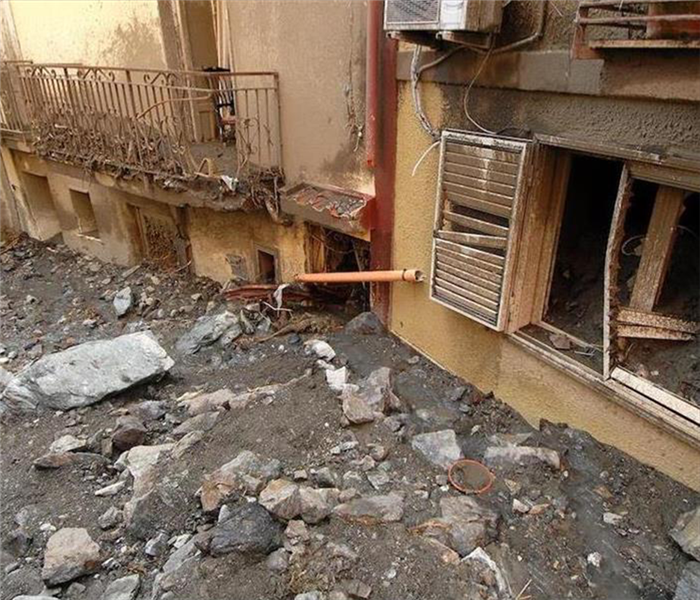 Don't let flooding devastate your home in Omaha. SERVPRO will help you to remediate and reconstruct.
Don't let flooding devastate your home in Omaha. SERVPRO will help you to remediate and reconstruct.
SERVPRO strives to be an industry leader in technology and innovation, employing systems, equipment, and communication techniques that give us an edge over any water damage situation. Our lineup of equipment includes advanced moisture detectors, monitoring equipment, well-optimized and planned drying systems, and more high-tech solutions to age-old problems. These are all intended to save both us and you time and money on restorations, as we can better understand the situation and deal with it in a more time-effective manner.
Moisture Detection
One of the most important steps we take when evaluating flood damage in Omaha is moisture detection. Using sensitive, top-of-the-line thermal moisture detectors, our crews are able to detect and map out pockets of water and moisture throughout your home. With this data, we can understand where to target our efforts and how much time and effort will need to be expended in each room. As a result, we don't waste resources on rooms that are mostly dried already, and don't end up missing spots of concern that may be hidden elsewhere in the home.
The ERP System
SERVPRO has recently introduced our new Emergency Ready Profile system, which allows you to create an online profile of your home and any other properties you may own that give us access to critical information in the event of a disaster. Time is often wasted trying to get critical information on floor plans, utility locations, contact lists and more, but all of these can be uploaded beforehand through the ERP system so that our technicians can have all the information they need before they even arrive. We strongly recommend taking advantage of the system so that future accidents can be handled with only the touch of a button.
Specialty Drying Setups
One of the most important steps in mitigating damage from floods is getting the home dried quickly. Fast drying means that water doesn't have time to seep in and cause lasting problems such as warping or cracking. We use industrial-grade equipment such as air movers to accomplish this goal, taking care to arrange them in specific formations so as to maximize their efficacy in dealing with the problem.
SERVPRO of Omaha Northwest carries a slew of advanced technology and strategies to help get your home back in shape ASAP after a flood. Call us 24/7 at (402) 800-2134.
Storm Blog- Winter Conditions
2/13/2020 (Permalink)
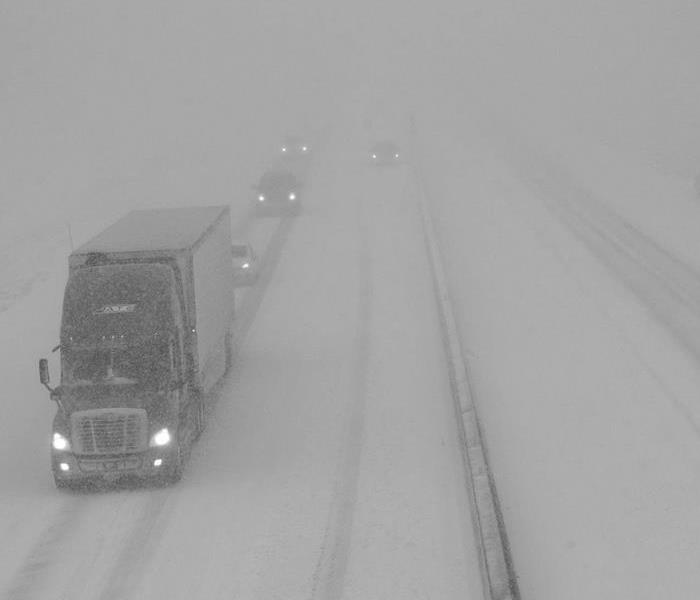 Driving conditions during a blizzard
Driving conditions during a blizzard
Each year Americans die from harsh winter conditions. This includes road accidents due to poor conditions, subzero temperatures and fires started by heating elements. Take winter warnings seriously and do not put yourself at risk if conditions are bad. Words to listen for include wind chill temperature, winter storm outlook, winter storm watch, and winter weather advisory. Listed below are some tips to stay safe and be prepared.
If under winter storm warning
- Stay off roads if possible
- Prepare for power outages
- Stay aware of emergency information
- Have a source of heat if electricity is not available
Prepare
- Make sure you have enough supplies to last at least a few days
- Food, water, etc.
- Warm clothing and blankets
- Be ready for a power outage
- Have other sources for heat
- Have supplies for fireplace or generator
- Have a source to charge phones and communication devices
During
- Keep your heat on as long as possible
- Limit travel and stay inside
- Wear warm clothes
- Be informed on weather updates
- Wait out the storm
Tips to Prevent Basement Flooding
12/26/2019 (Permalink)
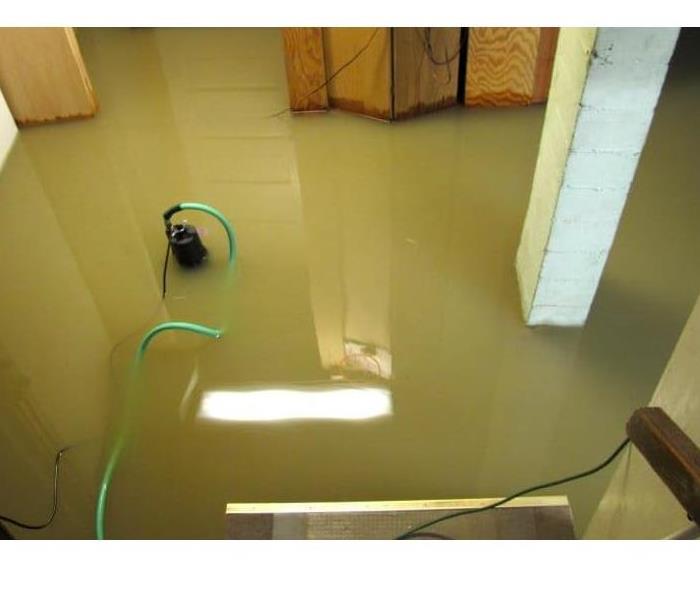 This is an example of what a flooded basement can look like after a flood or water loss
This is an example of what a flooded basement can look like after a flood or water loss
If your home is near a flood zone it is important to take all the correct steps to protect it. Having a plan in place can help prevent serious damage to your home. You should carry out a range of preparations and renovations. This includes maintaining gutters and downspouts, properly landscaping your yard, and inspecting and repairing foundation cracks. Follow some of the tips below to help protect your home.
Maintain gutters and downspouts
Cleaning and maintaining gutters are an essential part of making sure water can drain away from your home. Downspouts should direct water at least three feet away from your foundation to prevent pooling around your home.
Repair foundation cracks
It is very important to keep up with cracks with your home's foundation as this problem can become more serious over time. To prevent water damage and flooding, inspect the exterior of your foundation, floors, and walls on a regular basis. If you do notice any cracks, fill them epoxy.
Properly Landscape your yard
Make sure your landscape around your house is sloping away from your home. This will help direct water away from your house. If your landscaping is running towards your house there is a chance water will make its way into the basement.
Preparing Your Home for a Hailstorm
8/21/2019 (Permalink)
Hail storms are common in summer months and they don’t provide much warning. During these months it is good to have a game plan in place if hail decides to show up to your home. Hail can cause damage to your windows, gutters, siding, roof, and outdoor items. Follow these tips below to help plan and prevent damage to your home.
Windows
Hail has the ability to break or shatter windows in a major hail storm. One way to protect your windows is to include permanent shutters that can be closed when a storm is approaching. If that isn’t an option and your windows do break be sure to close your blinds to prevent wind blowing glass into your home.
Gutters
It is always important to keep your gutters clean during the storm season. If hail does arrive when your gutters are filled, they will not be able to drain properly. Without proper drainage, melting hail can cause water damage.
Siding
Some hail storms can damage the siding to your home. With that being said there isn’t much you can do to prevent it. On the positive side, homeowners insurance does cover it if you do get into this situation.
Roof
Before or during a storm there is almost nothing you can do to protect your roof to prevent it from damage, although after a storm you should inspect for any damage done by the hail. If nothing is done and it is damaged, you can cause serious problems for your home. Damaged shingles can cause leaks and other major problems down the road.
Outdoor Items
Anything left outdoors during a hail storms will most likely be damaged. It is important to plan accordingly for the storms and bring anything inside that could get damaged. This includes outdoor furniture and tables.
Protect Your Home from Storm Damage
8/20/2019 (Permalink)
Storms can bring all types of different weather and it is important for you to plan for it before a storm does hit. Sometimes storms can bring heavy winds, heavy rains, or even hails that can damage your home or business. Heavy storm rain and high winds can loosen building material including portions the roof and siding allowing water to come in. If this isn’t fixed in a timely manner the water soaks into the framing, foundation, adjoining walls, and flooring causing severe damage and mold. The steps you take to prepare you home before this happens can save in time and costly repairs.
How to reduce the chance for storm damage:
- Inspect your home and repair before the storm season hits
- Prepare in advance for a big storm or flood by placing sand bags to divert water from entering structure.
- Use tarps or boards to protect areas where structure is damaged
- Repair between storms
- Inspect after storm for damage
- Keep gutters clear
- Trim trees that could potentially fall on your home
- Make sure water can flow away from your home
Flood vs. Rain Damage
8/14/2019 (Permalink)
The difference between water and flood damage
At first glimpse, water and flood damage might seem to be the same thing but how water is getting into your home can be very different. A roof or window that is leaking can cause rain to intrude. Gutter and downspouts can also be a large contributor to rain damage. Flood damage however is caused by rising water. Improper grading, failing drainage, or rising rivers are all examples of how flood damage can occur. Both involve large amounts of water entering your home or business and can cause damage. Unfortunately, one of these types of damages is not included in a regular insurance policy.
Water Damage Insurance Claims
Water damage is usually covered by the insurance company under a standard policy. Water damage includes:
- Water damage cause by burst pipes
- Gradual water seepage due to cracks in the foundations of your home, business or other structures
- Mold or rot
Flood Damage Insurance Claims
Most of the time flood damage isn’t considered a type of water damage to the insurance company. For this reason, most businesses or homeowner’s policies do not cover flood damage unless you had purchased a separate policy. If you live in an area where flooding is common it might be worth investing in some type of flood insurance.
Summer Storms and Flooding
8/13/2019 (Permalink)
 Missouri River Flooding 2019
Missouri River Flooding 2019
It is good to know how to be prepared for storms in order to prevent damage to your home or property. Some factors that can cause flooding include heavy rains, overflowing rivers, and melting snow and ice. In previous months, snowmelt and rapid rainfall have caused catastrophic flooding across the Missouri River and other areas. These types of water related issues can potentially cause severe damage to homes and properties. With that being said, it is beneficial to know how to properly prepare for these types of situations.
Heavy Rains
When flooding does happen, it usually has to do with heavy rains in most cases. Our home structures are designed to move water away from our homes. In some situations that isn't always the case. Sometimes those systems are overwhelmed and that water does not drain nearly as quickly as needed. In short, the drainage systems back up, and the water rises, sometimes into homes. This typically happens only in cases of sustained heavy rains over a long period.
Overflowing Rivers
In some cases, it doesn't even need to rain in your area to cause a river to overflow. For example, if you live along a river and another town experiences heavy rains upstream it can cause a river to overflow. This causes damage to structures, crops, and communities. Larger rivers include a series of dams to help manage large amounts of rainfall. These river systems are managed by government authorities. However, those authorities have to make tough decisions about how to operate dams. They often can manage the water and prevent flooding altogether, but not always.
Melting Snow and Ice
In March, Omaha and surrounding areas had experienced rapid snowmelt. This was caused by warmer temperatures and rain. It not only contributed to a lot of water runoff, but it caused homes and basement to fill with water. House residents in areas susceptible to winter flooding need to prepare in advance for flood conditions.
How to Be Prepared
- Purchase a flood insurance policy if they do not already have one.
- Review their current insurance policy and become familiar with what is and is not
- Make a flood plan, plan evacuation routes and keep important papers in a safe, waterproof place
- Itemize and take pictures of possessions

 24/7 Emergency Service
24/7 Emergency Service
















